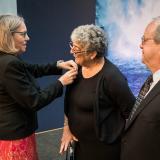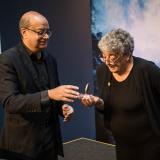2018 Gruber Genetics Prize
Joanne Chory, PhD, of the Salk Institute for Biological Studies in La Jolla, Calif., and Elliot Meyerowitz, PhD, of the California Institute of Technology (Caltech) in Pasadena, Calif., have been pioneers in discovering and describing the basic regulatory and biochemical mechanisms underlying the development of plants. Chory identified and characterized the hormonal signaling mechanisms that are key to understanding how plants regulate their growth in response to light and other environmental signals. Meyerowitz established Arabidopsis thaliana as the unified research model for the study of plant development. He also discovered the key transcription factors and regulatory mechanisms underlying flower shapes and patterns. Their contributions have helped to revolutionize the field of plant molecular biology, with broad implications for global agriculture, the environment, and human health and disease.
2018 Genetics Prize Recipients
Laureate Profile
Joanne Chory, PhD, of the Salk Institute for Biological Studies in La Jolla, Calif., entered the field of molecular biology during the 1980s, when plant research primarily involved maize and other food crops. Chory decided, however, to focus on Arabidopsis thaliana, a small flowering mustard plant, which was just emerging as a possible model for the study of plant genetics. In what is now considered a seminal experiment, Chory showed that when A. thaliana was germinated in complete darkness, a genetic flaw led to the creation of odd mutant plants with white leaves. She then set about analyzing the molecular pathways of those mutants, publishing the results in the journal Cell in 1989.
Despite skepticism from many molecular plant biologists that a single genetic flaw could impede a plant’s response to light, Chory persevered with her research. A string of remarkable findings followed. Chory announced in 1996 that her lab had discovered a new class of plant hormones — brassinosteroids — that play a crucial role in how plants respond to light. At that time, biologists did not believe plants used steroids as hormones. Chory went on to identify the cell receptor for brassinosteroids — the first confirmed steroid receptor in plants — and, eventually, to describe the entire brassinosteroid signaling pathway. Groundbreaking work on other plant hormones followed, including a series of findings regarding the biosynthesis and mode of action of auxin, a hormone that promotes, among other activities, plant stem and root growth. Chory’s lab also pioneered the use of genetic analysis to assign functions to each of more than a dozen plant photoreceptors, the tools used by plants to adapt quickly when their environment changes. More recently, Chory has helped launch the Harnessing Plants Initiative, whose goal is to develop plants that can more efficiently store carbon to reduce global warming.
Chory is considered one of the preeminent plant biologists in the world. Her work has transformed our understanding of how plants respond to changes in their environment — findings that have profound implications for other organisms and for the fields of agriculture, environmental science, and human health.
Elliot Meyerowitz, PhD, of the California Institute of Technology (Caltech) in Pasadena, Calif., began his career in molecular biology working on fruit flies (Drosophila melanogaster), but by the mid-1980s found himself more interested in plants. He was intrigued by some of the genetic aspects of plants that weren’t easily explained by the molecular biology known at that time. Plant genetics had no unified research model, however — a major impediment to the field. Meyerowitz set out to fix that problem with Arabidopsis thaliana, a small, flowering mustard plant. In a series of groundbreaking experiments, Meyerowitz demonstrated that the genome of A. thaliana had important characteristics that made it an extremely useful research model, most notably a small set of genes and very little repetitive DNA. He then created a molecular gene map for Arabidopsis — the first one devised for a plant — which he made accessible to anyone who wanted to use it. With a unified model now established, the field of plant genetics took off.
Meyerowitz continued to break new ground. Using Arabidopsis mutants, his lab developed the ABC model of flower organ development, which describes how the expression of three classes of genes leads to the development of flowers. This now-classic model has made it possible to control the timing and formation of flowers, a major breakthrough in helping to increase the yield of food crops. Other major achievements included isolating the first receptor for the growth-regulating hormone ethylene and then identifying the family of proteins that encoded it. Meyerowitz also developed a model for how stem cells in a plant’s shoot apical meristem (above-ground growing tip) guides the lateral positioning of flowers. In addition, he has been a leader in the computational modeling of plant patterning and growth, a field that promises to revolutionize plant development biology.
Watch Video
Citation
The Gruber Foundation proudly presents the 2018 Genetics Prize to Joanne Chory and Elliot Meyerowitz for their pioneering discoveries in genetic regulatory and biochemical mechanisms underlying plant development.
Joanne Chory discovered signaling pathways in plants that regulate responses to environmental signals. Elliot Meyerowitz pioneered the use of Arabidopsis thaliana to study plant development and he elucidated the regulatory mechanisms underlying flower shapes and patterns.

























































